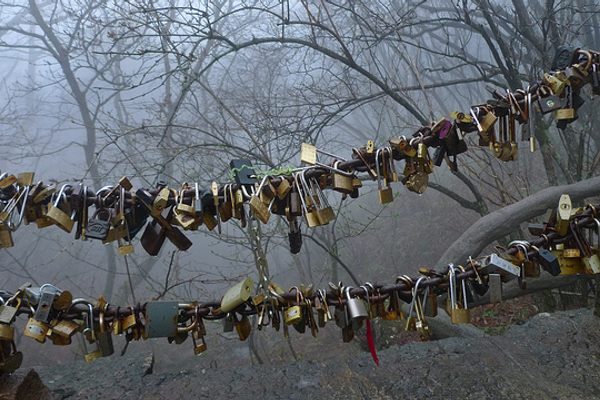I Locked My Love To An East London Fence
I am a sucker for romance, and that, combined with my ever-willingness to take part in a good art project (that doesn’t require too much of my limited artistic talent), made me a perfect candidate to add my padlock to the budding Shoreditch love lock fence.
As soon as I was tipped off to the emergence of the collection of padlocks opposite Shoreditch High Street station in East London, I couldn’t wait to visit.
I have read about and seen photographs of other love lock locations—a custom in which couples inscribe a message, their names, or initials on a padlock and affix it to a fence or other public structure, symbolically binding each to the other—but never had the opportunity to visit any in real life.
Now was my chance to not only see one in the flesh (or the metal, I should say) but to contribute to it and watch it grow.
Currently the Shoreditch fence is no rival to the iconic love lock locations of Europe and Asia, but the assortment of padlocks in different shapes and sizes, and the red, blue, yellow, green and purple wool and twine woven in and out of the diamond mesh fence in the shape of hearts, is a confident start.
I just hope that prosaic councillors or developers don’t stop it before it has the chance to really establish.
Padlock Tree Park in Moscow
Instead, they should take a cue from the Moscow authorities, who embrace the love lock tradition, and have erected metal trees leading up to, and along, the Luzhkov Bridge, over the Vodootvodny Canal. It has become a rite of passage for lovers local to, and visiting the area, to attach their inscribed padlock to one of the trees. It’s not uncommon to see newlyweds, and even brides in their wedding dresses, on the bridge securing their locks, and their love.
On the other hand, Paris officials learned the hard way. After clearing the magnificent accumulation of locks from the Pont des Arts bridge one night in 2010, they discovered them quickly reappearing on the Pont de l’Archevêché instead. They now accept the tourist attraction factor of the collections of locks now on both bridges—and the congruity of the “city of love” supporting expressions of love—and are permitting the love lock phenomenon to happen..
I’ve read that the tradition of love locks goes back to ancient China, where it is said that the securing of a padlock on the Mount Huangshan fence and the throwing of its key off the cliff symbolizes the immortal love of a pair of forbidden lovers who, legend has it, jumped to their death from the mountain, hand-in-hand.
In the small Serbian town of Vrnjačka Banj, young lovers affix padlocks to a local bridge in the hope of escaping the fate of a WWI-era schoolmistress whose sweetheart fell in love with another woman while he was away fighting, and never came home.
In the case of the Milvian Bridge, which crosses the Tiber in northern Rome, the custom can be directly attributed to a 2006 novel by Italian writer Federico Moccia, called I Want You. In it, the fictional couple pledges their love by attaching a lock to a lamp post along the bridge and throwing the key into the river below. Moccia attached a real lock to the lamp post a few days before the book was published to ensure readers who went there looking for it weren’t disappointed. Readers and lovers followed suit. But sadly local politician Gianni Giacomini recently ordered a crew of workmen to cut down all the locks which had accumulated on and near the bridge.
Back in East London, for me, it’s about leaving my mark in some small way on the streets of the capital with a public yet anonymous tribute to my sweetheart—becoming part of a communal romantic affirmation and participatory public art installation.
And every time I pass that fence at the top of Bethnal Green Road, I smile at my padlock hanging proudly alongside the other metallic declarations and yarn-based expressions of love.
Long may it, and love, last.






Follow us on Twitter to get the latest on the world's hidden wonders.
Like us on Facebook to get the latest on the world's hidden wonders.
Follow us on Twitter Like us on Facebook